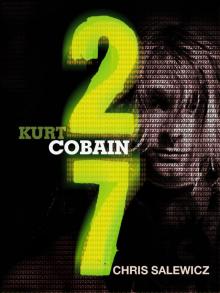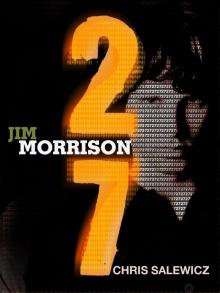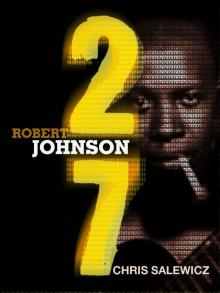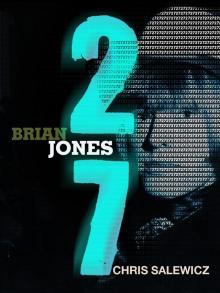- Home
- Salewicz, Chris
27: Brian Jones Page 5
27: Brian Jones Read online
Page 5
*
Anita, meanwhile, had been cast in the lead role in a film being made by German director Volker Schlöndorff. It was called A Degree of Murder, the story of a girl who accidentally kills her boyfriend with his own gun as he attempts to beat her. Shooting was set to start at the beginning of 1967 and Brian was taken on to write the score. He moved to Munich, staying with Anita in Schlöndorff’s apartment for the duration of the filming. The director had taken Brian on for the role not simply as a sop to Anita:[23] ‘I liked Brian and trusted him. You could feel that he had a lot of creativity. He was a poet, an enfant terrible it’s true, but he was very much in touch with his time and he was also very much in love with Anita, the only actress in the movie – and its soul. She was bound to inspire him. I know he loved her, and I think she loved him. She was certainly in love with his lifestyle.’ On the soundtrack Brian drew on his by now familiar panoply of instrumentation: sitar, organ, dulcimer, harmonica, autoharp, flute, piano, violin, banjo and saxophone. Later brought in by Brian to add further textural instrumentation were Yardbirds’ guitarist Jimmy Page, renowned session pianist Nicky Hopkins and Small Faces’ drummer Kenney Jones.
In London, where Volker Schlöndorff followed Brian to get him to complete the score, the director felt he had become much more moody, an air of permanent upset hanging over him. ‘There was obviously tension within the Stones too. It was very clear that Brian wanted more profile or he would go his own way.’
While the director had become fond of Brian, he was struck by his barely concealed paradoxes. ‘Brian was extremely likeable … Yet he wouldn’t often allow you to like him … There was also something definitely devilish about Brian. He’d sense your weakness with incredible intuition and, if the mood took him, he’d exploit it. On the other hand, he could turn around and be incredibly nice to you. I liked Brian, but he was a complicated guy.’[24]
*
It wouldn’t have seemed like a new year if the Rolling Stones had not begun 1967 with more of their by now habitual controversy. On Friday 13 January they released a new single, ‘Let’s Spend the Night Together’ – a title which seemed a little obvious, immature and humourless in its efforts to create media uproar. Although perfectly catchy, a tiredness also lay at the heart of the tune, with the suggestion that the cod-naughty lyrics were chosen to boost its rather uninspired melody and riffs. No doubt precisely as the group hoped, various American radio stations immediately banned the song, thereby only enhancing its word-of-mouth reputation. The B-side was ‘Ruby Tuesday’, a Keith composition about Linda Keith, featuring Brian on flute. In the United States, ‘Ruby Tuesday’ began to be promoted more and more, until it became a number 1 record. In Britain ‘Let’s Spend the Night Together’ remained the A-side, however, and the Stones plugged it on 22 January on the Sunday Night at the London Palladium ITV programme. This was a variety show with an enormous mass-market audience that the Beatles had always exploited to the maximum.
When the Stones arrived at the Palladium, behind Oxford Circus, matters did not kick off especially auspiciously. Keith and Brian turned up together, tripping on LSD, and Brian immediately placed a large water-pipe on top of the piano. Such gestures were considered radical in those times.
The London Palladium date was not only intended to plug the single. Two days before it, the Stones had released yet another new album, Between the Buttons, the fruits of August sessions in Los Angeles. It was the first album that the Stones had recorded with a conceptual approach. In Britain’s NME, longstanding Stones’ supporter Roy Carr gave it a very bad review. There was no getting away from it – it was a weak album, the songs sounding like outtakes from the Aftermath sessions.
But in America it received a largely ecstatic response. The cover of the album was another picture by Gered Mankowitz: an archetypal shot of the group hunched up in their overcoats against the early morning chill, taken on Primrose Hill in north London after an all-night recording session.
There was another significant factor about that Gered Mankowitz shot: on the cover picture for Out of Our Heads, which Mankowitz had also taken, Brian was right up at the front of the group. Sixteen months later, for the insubstantial, confused Between the Buttons album, he was right at the back, like an afterthought that was fading away.
*
On 5 February 1967, the News of the World ran an article in which it alleged that the Stones’ singer had taken LSD at the London home of the Moody Blues. In the article a pair of reporters described how they had met ‘Mick Jagger’ at Blaise’s night club in South Kensington. While there he had taken six Benzedrine amphetamine tablets and brandished a lump of hash. He was also said, highly implausibly, to have admitted to having first taken LSD while on the road with Bo Diddley and Little Richard. ‘I don’t go much on it now the cats (fans) have taken it up. It’ll just get a dirty name.’
It wasn’t Mick, of course; it was Brian, seeing straight through the reporters and sending them up in his customarily supercilious manner. This didn’t especially help Mick, and proved even more damaging for Brian, for whom the small episode in a nightclub would ultimately have disastrous consequences, both inside and outside the group.
The next day a writ for libel was served by Mick Jagger on the News of the World. As a consequence the Sunday newspaper put even more reporters onto investigating Mick’s drug habits.
Now matters began to gather pace. David Schneiderman, a self-styled ‘acid king’ whom Keith and Brian had met in New York on the Stones’ last US tour, arrived in London. He brought with him, he said, a suitcase full of top-grade LSD. Keith and Brian were out of town, having flown to Munich to watch Anita filming in A Degree of Murder.
When Keith returned on Friday 10 February, and learned Schneiderman was in town with his bag of goodies, he suggested a select group should go down to Redlands, a country house in East Sussex he had recently purchased, to sample these wares. The Beatles were invited, but only George Harrison and Patti Boyd could make it. Tired from working on the Schlöndorff soundtrack, Brian and Anita were late. Brian called Keith to apologize, at the very moment that police burst into Redlands. ‘Don’t bother, Brian: we’ve all just been busted!’ Keith told him over the phone.
*
Like an executioner’s axe, the full force of the British establishment was hovering over the collective neck of the Rolling Stones. Accordingly, assorted members of the cast decided to leave the UK, with Morocco as their chosen destination.
Attempting to create a smokescreen around their eventual destination, Keith, Brian and Anita flew to Paris, checking into the George V hotel. Tom Keylock, who worked for the Stones, took the ferry and drove to the French capital in Keith’s Bentley with its black-tinted windows.
Bombing through the countryside south of Paris Brian was aware of an almost palpable psychic bond between his girlfriend and Keith. Attempting to anaesthetize himself to this in the only way he knew how, he passed the first day’s journey by pouring copious quantities of French cognac down his throat and chain-smoking joints, each containing enormous amounts of hashish. By the time they were fifty miles out of Toulouse, this intake, as well as the sexual vibes in the car, had caught up on Brian, and he could hardly breathe. Was it an asthma attack? Or something more serious? No one seemed to know. Whatever the cause, he was admitted to the Centre Hospitalier d’Albi outside Toulouse.
At Brian’s insistence, the other occupants of the Bentley left him there, continuing on their way through the Pyrenees into Spain. Anita ignored a telegram sent by Brian, asking her to meet him from hospital. In Valencia Keith and Anita spent the night together, but agreed to treat it as a passing whim. Finally, after Anita had spent four more nights with Keith in Marbella, she flew up to Toulouse to meet Brian on Sunday 5 March. Five days later the couple flew back to London for Brian to undergo further medical tests.
On 9 March, Marianne Faithfull – who had replaced Chrissie Shrimpton in Mick Jagger’s affections – fl
ew from Naples to Tangier to meet up with Mick. In Tangier the Stones’ party took over the entire tenth floor of the Hotel Minzah. The artist Brion Gysin was in the city and came by to hang out with them. On 15 March Brian and Anita finally arrived in Tangier. That night, after they had been tripping, Brian and Anita began to argue yet again. After Anita had taken sleeping tablets and locked herself in her bedroom, Brian left and picked up a pair of tattooed Berber whores. After bringing them back to the hotel, he tried to persuade Anita to have group sex with them, smashing up the room and beating her when she refused. She fled to Keith’s room and spent the night with him. The next day Anita sat in a canvas swing by the deep end of the pool, her gaze held by Keith in the water.
That evening they learned that a plane-load of Fleet Street’s finest was on its way to Tangier to track down the party. Immediately, they made off to Marrakech.
*
In Marrakech, they checked into the Sadi Hotel. ‘We’re all in Marrakech,’ Keith said. ‘Cecil Beaton’s there, Robert Fraser, Brion Gysin, Mick, and the airs’s like heavy, lots of people doing acid. I’m feeling guilty.’
‘They were a strange group,’ wrote Cecil Beaton, the photographer, in his diary. ‘The three Stones: Brian Jones and his girlfriend Anita Pallenberg – dirty white face, dirty blackened eyes, dirty canary drops of yellow hair, barbaric jewelry – Keith R. in 18th century suit, long black velvet coat and tightest pants, and of course, Mick Jagger. He is sexy, but completely sexless. … None of them is willing to talk, except in spasms. No one could make up their minds what to do, or when.’
The next day Brion Gysin was persuaded to take Brian to the nearby Atlas Mountains, to hear the celebrated pipe sounds of the Master Musicians of Jajouka.
As soon as he had gone, Keith bundled Anita into his car and they drove back to Tangier. Everyone else also left, leaving a shocked, hurt Brian to pay the bill for the entire party. Keith and Anita caught a ferry to Spain.
The couple only drove as far as Madrid, where they took a plane to London. There, Keith and Anita went immediately to the crash pad that Keith still kept in St John’s Wood, the scene of his dying relationship with Linda Keith.
Brian flew to Paris to briefly stay with Donald Cammell, the society painter who would shortly co-direct Performance, arriving on his doorstep drunk, with his customarily elegant clothes in tatters. Then, in deep emotional pain, he returned to London. He drove over to the flat in St John’s Wood and when Keith opened the door, he collapsed on the carpet in front of him, beseeching Anita to return. This was not to be the last such occasion. For a long time Brian refused to accept that Anita had left him, just as he had refused to accept that he was no longer ‘leader of the Rolling Stones’. ‘He never forgave me,’ said Keith. ‘I don’t blame him.’
Anita’s leaving Brian for Keith Richards was devastating to him and Brian’s father believed the shock of this altered the entire course of his life. ‘He changed suddenly and alarmingly from a bright, enthusiastic young man to a quiet and morose and inward-looking young man,’ said Lewis Jones in 1971. ‘In our opinion he was never the same boy again. I’ve always been concerned that that was the turning-point in his life.’
The day Brian returned from Paris, the Daily Mirror reported that Mick and Keith were to be charged for offences against the drug laws: Mick for illegal possession of amphetamines, and Keith for ‘premises’, which found the owner or landlord of any property in which there was illegal drug consumption to be as guilty as those partaking of the particular substance.
*
A week after Brian had finally returned from Morocco on 18 March 1967, the Rolling Stones began a three-week European tour, opening in Malmo in Sweden. After Sweden, the group raced through four dates in Germany: in Bremen, Cologne, Dortmund and Hamburg. Anita Pallenberg, whom Brian had met in Germany, had gone off with the guy who stood on the other side of Mick Jagger onstage. So it was an uneasy Brian who embarked with the group on this tour, while Keith was conscious all the time of Brian’s bitter resentment. ‘Mr Shampoo’, however, was unaware that at this stage Anita, who had gone to Italy for another film part, in Roger Vadim’s sexual science-fiction fantasy Barbarella, had not in fact committed herself to Keith – although she had committed to leaving Brian. Just to add to the atmosphere of confusion, despite having apparently won Anita, Keith began an affair with a German model called Uschi Obermaier, who accompanied him to the quartet of German shows. This seemed only to rub Brian’s face even deeper into the dirt of his depression, a personal shame that would have been magnified a thousand times if he had appreciated this was the last time that he would tour with the Stones.
In mid-May Keith and Anita flew to Cannes for the annual film festival. A Degree of Murder was Germany’s official entry that year. As Brian had composed the musical soundtrack, he also arrived in the south of France, checking into the same hotel as Keith and Anita. The first night he was there, Brian tried to persuade Anita to go back to him, as Keith waited patiently in his room.
*
At 4 p.m. on 22 June 1967, around the same time as Mick and Keith – having elected for trial by jury – were leaving court at West Sussex Quarter Sessions, Brian was busted for possession of cannabis at the flat in Courtfield Road. With him was a friend, 24-year-old Prince Stanislaus ‘Stash’ Klossowski de Rola. The pair appeared the next morning at West London Magistrates, where Brian also elected for trial by jury. Ever a worrier, Brian was to be driven literally sick by these events.
On 15 June Mick and Keith added vocals to ‘All You Need Is Love’, the Beatles’ next single. When it was released on 7 July, the B-side – ‘Baby You’re a Rich Man’ – featured Brian playing soprano saxophone. The day after the recording at Abbey Road, Keith and Anita flew to Paris. Mick, Marianne, and Marianne’s son Nicholas and his nanny went to Tangier.
Brian, however, flew to northern California, accompanied by Stones’ manager Andrew Loog Oldham, for the weekend of 16 to 18 June. His destination was Monterey Pop, south of San Francisco. This was the first of the ‘Love Generation’ mass festivals, at which Brian arrived in the Mamas and Papas’ private plane, and where Brian introduced the set by his friend Jimi Hendrix. The event, at which drug consumption was blatant, marked a significant cultural shift: the symbolic inauguration of ‘rock music’ as a creative entity – and marketing force.
Brian’s presence at Monterey indicated that – unlike the rest of the Rolling Stones – he was as in touch with the zeitgeist as when he had decided to form a blues group. So moved was Brian by the festival’s spirit that he gave a rare interview, to Beat magazine. ‘I just came away for a few days and it’s so nice to get on someone else’s scene. It’s a very beautiful scene happening here,’ he told the reporter, saying he regretted the other Stones had not also come to California with him. ‘We record practically all the time as the Beatles do. We just got about a week off so I came over here with Andrew. The others have sort of split to various places, I think, I’m not quite sure. But nobody seemed to get it together to come over here. I wish they had ’cause they have missed a very nice scene.’
In the lace-encrusted wrap he wore at the festival, Brian looked like a mediaeval English monarch – apart from the can of Budweiser that was permanently in his hand. Hanging at Monterey with Nico, singer with emerging act the Velvet Underground, earned them the rubric of the King and Queen of Monterey Pop.
‘A lot of people have been sort of critical of this kind of happening in this country. The uptight people,’ the Beat interviewer said to him.
‘They’re frightened of trouble but I don’t expect any trouble, do you?’ considered Brian. ‘It has been wonderful. I have been walking freely amongst everybody. Yesterday I was walking through and joining rings of kids and fans. You know I’ve never had a chance to do that much before. People are very nice here. I like it.’
Brian also revealed how he’d been spending his time: ‘I did a Beatles’ session the other night, a
ctually. On soprano saxophone, of all things. I’ve taken up playing reeds again. I used to play reed instruments. I bought a soprano saxophone the other day and ever since I have been doing sessions on it. There are soprano saxophones on the Stones’ records, future Beatle records. You know, it’s a funny thing – you get hold of something and put it on everyone’s records. It’s great. There’s a very nice recording scene going on right now in London.’
Most of his time, he said, had of late been spent working on the new Stones’ album ,Their Satanic Majesties Request: ‘The big job at hand is to get the LP done and we’re spending an awful lot of time on it this time. It’s going to be more of a production. We’ve really put some thought into it because people are still liking our albums so we’re trying to really give them something that will take them on a stage further. And so that they will take us on a stage further. We feel at the moment that our important work is to be done in the studio rather than in baseball halls and stadiums around the country. You see, once you’ve been around the country once or twice people have seen you and it’s a question of what’s to be gained by going around again. But, there’s a lot to be gained by letting them share our progressions because we are progressing musically very fast.’
Of Monterey Pop itself, Brian Jones seemed to sense its far-reaching effect, giving a glimpse of his abiding political idealism: ‘I would like to see these affairs become a regular part of young community life because I think these people here – from what I’ve seen so far – are acting as a community. They have the community spirit, the community feeling. I haven’t seen any signs of any trouble or enmity. It’s very nice. People are showing each other around and it’s very beautiful. I’m glad I came. I’ll have lots of nice things to say when I get back home.’[25]

 27: Kurt Cobain
27: Kurt Cobain 27: Jim Morrison
27: Jim Morrison 27: Robert Johnson
27: Robert Johnson 27: Brian Jones
27: Brian Jones